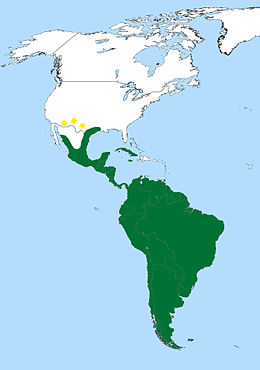Olive shard
| Olive shard | ||||||||||||
|---|---|---|---|---|---|---|---|---|---|---|---|---|

Olive shag ( Phalacrocorax brasilianus ) |
||||||||||||
| Systematics | ||||||||||||
|
||||||||||||
| Scientific name | ||||||||||||
| Phalacrocorax brasilianus | ||||||||||||
| ( Gmelin , 1789) |
The olive shag ( Phalacrocorax brasilianus ), formerly ( Nannopterum brasilianus ), is a species of bird in the cormorant family. The mainly brown or black colored species colonizes the American continent from the southern USA to Tierra del Fuego , breeds in colonies and feeds mainly on fish and amphibians . The IUCN lists the species as "not endangered" ( least concern ).
Appearance
Olive shags reach a head-body length of 58 to 73 centimeters and a wingspan of a maximum of 101 centimeters. The maximum weight is 1814 grams. Adult birds have dark brown to black plumage all over their bodies, their legs are black. The beak is gray in color, which turns into a strong yellow at the base of the beak. In breeding birds, the feathers around the base of the beak are colored white, some populations also show a horizontal white line on the sides of the head. After breeding, however , these feathers are moulted , the birds then have a single-colored dark brown or black feathered head. The iris is bright green in color. There is no gender dimorphism . Individuals of the South American subspecies Ph. B. brasilianus are on average slightly smaller than animals from the northern part of the range.
Young birds are lighter brown in color than adult birds, and on the belly, chest and throat they can be almost white.
distribution and habitat
Olive shags colonize all of South America , Central America , Cuba and the coasts of Mexico as far as the southern USA . They occur only sporadically further north.
Both inland wetlands and the coast are populated as habitats. Shallow waters are preferred, as this is where the species finds better conditions for foraging. Islands in the open sea are not populated. The birds rarely move more than a few hundred meters from the coast. In the interior, slow-flowing rivers and lakes are mainly populated at lower altitudes, but in the Andes the species is also found at altitudes of 4,000 meters.
Diet and Lifestyle
The main part of the food is made up of small fish , which usually do not exceed a length of 5 to 10 centimeters. Other components of the diet are crabs , amphibians and aquatic invertebrates . Like all cormorants, the species prefers to catch its prey by diving by following and catching it while swimming underwater. The olive shag is the only type of cormorant to use shock diving along the coast to catch fish. The hunt is often carried out in groups, with several individuals swimming in a row on the water, driving the prey fish in front of them towards the bank, where they can be more easily captured.
Since the plumage of the olive pod absorb water, it must be dried after a dive. Like most cormorants, olive shags spread their wings and let the sun or wind dry their plumage.
Reproduction
The breeding season depends on the rainy season and varies depending on the geographical location. Olive shags living in the tropics can breed all year round, while birds in the northern and southern distribution areas begin breeding with the onset of the rainy season in early summer. The species breeds in colonies of up to several thousand breeding pairs. Preferred nesting sites are cliffs and steep rock slopes, where these are not available the nests are built in trees. The nest is built from sticks and padded with grass , algae and feathers. As a rule, 3 to 4 eggs are laid, from which naked chicks hatch after an average incubation period of 30 days. Black down grows after a few days . On average, depending on the food supply, 1.7 young birds in a brood fledge.
hikes
In large parts of the distribution area the species is a resident bird , there is only dismigration , especially of young birds, over shorter distances. The population of the Andes moves over short distances into lower areas in winter. Occasionally, a few animals also appear in the central United States.
Geographic variation
As with all cormorants, the exact systematic position of the species and the number of its subspecies is disputed. Usually, however, two subspecies are recognized.
- Phalacrocorax brasilianus mexicanus ( Gmelin , 1789) - Southern United States , northwestern Mexico , Central America , Bahamas, and Cuba
- Phalacrocorax brasilianus brasilianus ( Brandt , 1837) - Panama to southern South America
Systematics
As early as 1658 the olive shard was discovered and documented by the Dutch explorer Willem Piso on an expedition to northeastern Brazil and was first described on this basis by Johann Friedrich Gmelin as Procellaria brasiliana in 1789 . In 1805, Alexander von Humboldt described the species again as Pelecanus olivaceus . The first description of Gmelin was considered controversial by many authors. Today, however, many authors give it priority due to closer examination of the records made by Piso .
Hazard and protection
The IUCN lists the species as “ least concern”, as it occurs in large numbers in large parts of its range. Populations are hunted locally - especially in South America, where fishermen see them as competitors. It is assumed that the population in the southern USA will increase, as more animals have been sighted in areas that have not been permanently populated until now.
literature
- Josep del Hoyo , Andrew Elliot, Jordi Sargatal : Handbook of the birds of the world. Volume 1: Ostrich to Ducks. Lynx Edicions, Barcelona 1992, ISBN 84-87334-10-5 .
Individual evidence
Web links
- Nannopterum brasilianus in the endangered Red List species the IUCN 2008. Posted by: BirdLife International, 2009. Accessed March 14, 2011th
- Videos, photos and sound recordings of Phalacrocorax olivaceus in the Internet Bird Collection
